Serviços Personalizados
Journal
Artigo
Indicadores
-
 Citado por SciELO
Citado por SciELO -
 Acessos
Acessos
Links relacionados
-
 Similares em
SciELO
Similares em
SciELO
Compartilhar
Silva Lusitana
versão impressa ISSN 0870-6352
Silva Lus. vol.19 n.Especial Lisboa 2011
Predicting Defoliation by Pine Processionary Caterpillar, Thaumetopoea wilkinsoni (Lepidoptera: Notodontidae) in Young Pinus brutia Plantations in Northern Cyprus
William M. Ciesla 1, Musa Erkanat 2 and Cemal Akeson 2
1 Forest Health Management International, Fort Collins, CO, USA
2 Forest Department, Turkish Republic of Cyprus, Nicosia, CYPRUS
Abstract
A method is described for predicting severity of defoliation of young Pinus brutia plantations (<2.5 m in height) by pine processionary caterpillar, Thaumetopoea wilkinsoni (Lepidoptera: Notodontidae), based on counts of egg masses or early instar larval colonies. Severity of defoliation is expressed on a 6-class numerical scale adapted from a method of describing the level of infestation by parasitic plants of the genus Arceuthobium in North American conifer forests. This system can be used to select one of three pest management alternatives: no action, removal of colonies by hand pruning or treatment with Bacillus thuringiensis.
Key words: Pine processionary caterpillar; Thaumetopoea wilkinsoni; defoliation; egg masses; larval colonies; pest monitoring
Predição da Desfolha pela Processionária do Pinheiro Thaumetopoea wilkinsoni (Lepidoptera: Notodontidae, em Plantações Jovens de Pinus brutia no Norte do Chipre
Sumário
Um novo método é apresentado para prever a severidade da desfolha causada pela processionária do Pinheiro Thaumetopoea wilkinsoni (Lepidoptera: Notodontidae) em plantações jovens (<2,5 m altura) de Pinus brutia. Este método é baseado na contagem de posturas ou lagartas jovens. A severidade da desfolha é expressa numa escala numérica com seis classes de intensidade, que foi adaptada de uma metodologia usada para descrever o nível de infestação por plantas parasitas do genus Arceuthobium em florestas de coníferas da América do Norte. Este sistema pode ser usado para selecionar uma de três opções de gestão desta praga: ausência de intervenção, remoção manual das colónias ou tratamento das mesmas com recurso a Bacillus thuringiensis.
Palavras-chave: Processionária dos pinheiros; Thaumetopoea wilkinsoni; desfolha; posturas; instares larvares; monitorização de praga
Introduction
The pine processionary caterpillar, Thaumetopoea wilkinsoni (Lepidoptera: Notodontidae), is a major defoliator of pines in the Mediterranean Basin. Repeated defoliation, especially of young trees, can cause growth loss and tree mortality. In addition, the urticant hairs of the larvae can cause skin irritation in certain individuals. Therefore, the insect is also a public health problem.
In the year 2000, the Forest Department of Northern Cyprus requested financial and technical assistance from the United Nations (UN) and the U.S. Agency for International Development (USAID) for management of an outbreak of pine processionary caterpillar that was causing defoliation of young pine plantations. One of the technical services requested was the development of criteria according to which plantations would be treated.
The concept
The work was focused on young pine plantations with trees up to 2.5 meters in height. Estimates of both egg-mass and larval colony numbers were based on whole trees.
The envisioned end product of this work was to:
1. Determine optimum sample size for estimating the number of egg masses and early instar larval colonies.
2. Establish a relationship between egg-mass counts, larvae and defoliation at the end of the larval feeding period that could be used to predict defoliation intensity.
3. Establish thresholds of egg-mass and larval colony numbers to determine the need for control and type of control using a two-threshold system:
a. Below threshold 1, no action would be taken.
b. Above threshold 1, mechanical control consisting of removal of pine processionary caterpillar colonies would be undertaken.
c. Above threshold 2, aerial or ground applications of the biological insecticide Bacillus thuringiensis would be applied.
Methods
Optimum sample size
In order to establish a sound basis for selection of sample size (number of trees in a plantation), egg-mass data collected in December 2000 from two adjoining Pinus brutia plantations in the Diorios/Tepebasi Forest, Northern Cyprus, were analyzed. The plantations were established in 1987 and the trees were somewhat less than 2 meters in total height at the time of data collection. Counts of the total number of pine processionary caterpillar egg masses were made on each of 30 sample trees per plantation. The sample trees were selected randomly along a diagonal line across each plantation.
The following statistics were computed for each plantation and for the two plantations combined:
1. Average number of egg-masses/ tree
2. Range of egg-mass numbers
3. Standard deviation
4. Standard error
5. 95 and 99% confidence limits
Using a procedure described by FREESE (1967), the optimum number of sample trees was determined from the following relationship:

where:
n = Optimum sample size
t = Value of t at n-1 degrees of freedom
s = Standard deviation of the mean number of egg-masses per tree
e = Level of precision desired (± x egg masses/tree)
The optimum number of sample trees needed was determined for each plantation and the two plantations combined, for the following levels of precision:
± 2 egg masses 95 out of 100 times
± 1 egg mass 95 out of 100 times
± 2 egg masses 99 out of 100 times
± 1 egg mass 99 out of 100 times
Average egg masses per tree for plantations 1 and 2 were 5.97 and 6.97 respectively. The range of egg masses per tree varied from 0-24 in plantation 1 and 0-45 in plantation 2 (Table 1). Other basic statistics about each plantation and the two plantations combined are summarized in Table 1.
Table 1 - Egg mass densities and sampling errors for two pine plantations in the Diorios/Tepebasi Forest, Northern Cyprus, December 2000
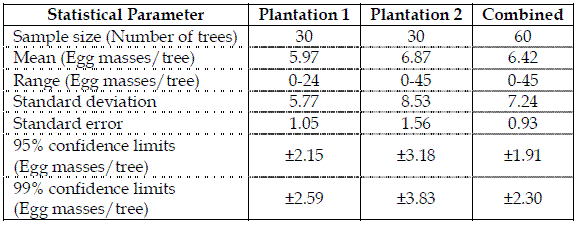
Recommendation for optimum sample size is based on average egg-mass densities, their variability and on practicality. The best combination appears to be to attempt to achieve a precision of ± 2 egg masses 95 out of 100 times. This resulted in a required sample size of 33 trees in plantation 1 and 72 trees in plantation 2 (Table 2). The larger optimum number of sample trees in plantation 2 is attributed to the wider range of egg-mass numbers per tree (0-45) The combined data show an optimum sample size of 52 trees per plantation (Table 2).
Table 2 - Optimum sample sizes for estimating numbers of pine processionary caterpillar egg-masses/tree in the TCC on trees up to 2 m in height based on data collected from two plantations in the Diorios/Tebebasi Forest, Northern Cyprus, December 2000

Egg-mass and larval colony surveys
Thirty sample plantations were selected throughout the Pentadactylos (Five-Finger) Mountains for egg-mass/larval surveys in the 2002-2003 field season. These plantations were established between 1986 and 1998 and consisted of trees up to 2.5 meters in height. Some were pure Pinus brutia plantations and others were mixed plantations of P. brutia, P. halepensis and Cupressus sempervirens. Between 30 and 45 sample trees (P. brutia and P. halepensis) were selected on parallel transects across each plantation (Figure 1). Each tree was numbered and examined for presence of egg-masses and larval colonies. Data for each tree was recorded on a field data sheet. Elevation (meters) was also recorded for each plantation.
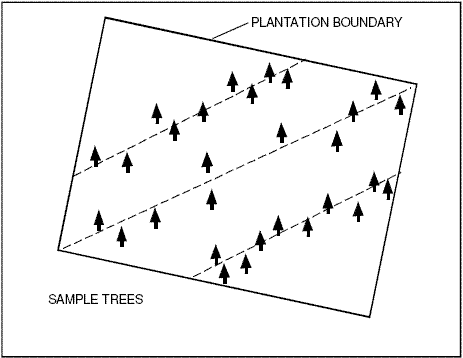
Figure 1 – Sample trees along diagonal transects in a pine plantation for egg-mass and larval colony sampling
Fourteen of the plantations were examined for egg-masses from 9-11 October 2002. These were recounted in early December because of problems with the first set of egg-mass counts. Counts of egg-masses and larval colonies were done simultaneously in early December for the remaining sample plantations.
Rating defoliation
A method for classifying the intensity of defoliation on sample trees was adopted from a procedure developed in North America for rating the intensity of infestation in conifers by parasitic dwarf mistletoes, Arceuthobium spp. This system, referred to as the Hawksworth 6-class rating system (HAWKSWORTH, 1977) consists of dividing the tree crown into three levels and rating severity of infection into three numerical classes (Figure 2). The sum of the crown ratings is the tree rating and the plot rating is the average value of the tree ratings.
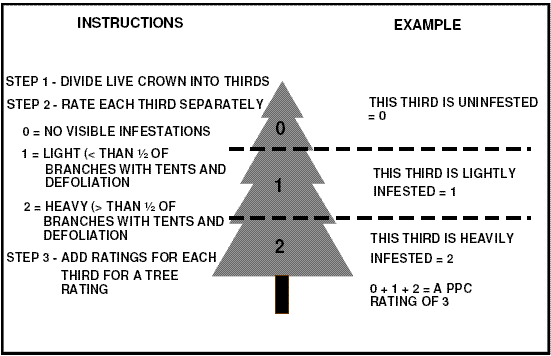
Figure 2 – Pine processionary caterpillar rating system adapted from HAWKSWORTH (1977)
For pine processionary caterpillar, the three numerical classes were:
0 – No defoliation present
1 – < 50% of the branches defoliated and/or larval colonies present
2 – > 50% of the branches defoliated and/or larval colonies present
This rating system provides a range of individual tree and plot ratings from 0 to 6 depending on the severity of defoliation.
Results
Timing of egg-mass surveys
Initial screening of the data from sample plantations in which egg-mass surveys were conducted in early October had higher larval colony counts than egg-masses. Recounts of egg-mass numbers in these plantations during early December indicated that more egg masses were found in December. October egg-mass counts ranged from 33 to 94.2% of the egg masses found in December (Table 3). This discrepancy in egg-mass counts was believed to be the result of three possible scenarios:
1. October egg-mass surveys had been conducted before adult flight and oviposition were completed.
2. Egg-masses produce more than one larval colony.
3. Field crews did not detect all egg-masses present.
Table 3 - Percentage of Pine Processionary Caterpillar Egg Masses Detected by First Egg-Mass Sample, Five-Finger Mountains, Northern Cyprus, 2002
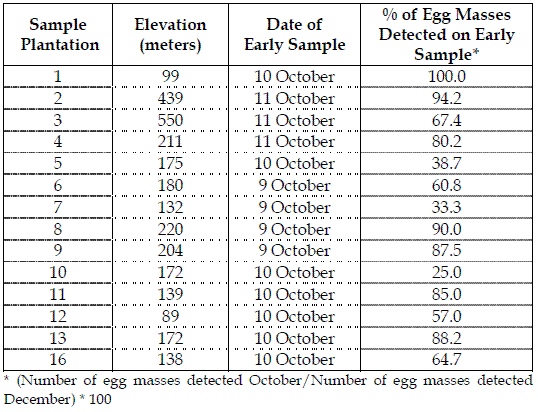
If this discrepancy was due to egg-mass surveys being done before adult flight was completed, the greatest discrepancy between the two sets of egg-mass counts should have occurred in the low elevation plantations where adult flight and oviposition occurs later than at the high elevations (BUXTON, 1983). However, comparison of the proportion of egg-masses detected in October by elevation failed to show a clear trend (Table 4). It is, therefore, believed that the discrepancies between the October and December egg-mass counts are the result of all three factors listed earlier. Egg-mass counts taken in December were used in the analysis.
Table 4 - Percent of Egg Masses Detected by First-Egg Mass Sample, by Elevation Zone, Five-Finger Mountains, Northern Cyprus, 2002

Data ranges
The average number of egg-masses/tree for the 30 sample plantations ranged from a low of 0.20 to a high of 4.23. These were lower than the values obtained for the two plantations sampled in 2000. Larval colony densities per tree ranged from 0.20 to 4.49. Estimates of larval colonies were higher than estimates of egg-masses/tree in 11 of the sample plantations (Table 5).
Table 5 - Distribution of Sample Plantations by Egg-Mass and Larval Densities, Five-Finger Mountains, Northern Cyprus, 2002
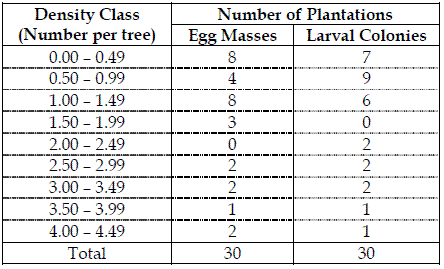
Estimates of precision
Estimates of numbers of egg-mass densities per tree was within ± 0.5 egg-masses/ tree 95 out of 100 times in 25 out of the 30 sample plantations and within ±0.69 egg masses on the remaining sample plantations. This was considerably higher than the expected precision of ± 2 egg-masses 95 out of 100 times based on the data collected in 2000, especially considering that none of the sample plantations contained the recommended number of 50 sample trees. This is believed to be due to higher numbers of egg-masses on individual sample trees in 2000. One of the trees sampled in 2000 had 45 egg-masses (Table 1). This is probably unusual and adversely affected the estimate of sampling error. In 2002, the highest egg-mass count obtained on a single tree was 15.
The precision of estimates of the numbers of larval colonies per tree was similar to the estimates of egg-mass densities. In 25 of the 30 sample plantations, estimates were within 0.5 larval colonies 95 out of 100 times. In the remaining five plantations, the estimate was within ±0.67 larval colonies/tree.
Egg-mass/ Larval colony/ Defoliation correlations
Regression analyses using the linear model y = a + bx (FREESE, 1978) was made for three relationships:
1. Egg masses/ tree (x) vs. early instar larval colonies/ tree (y)
2. Egg masses/ tree (x) vs. defoliation rating (y)
3. Early instar larval colonies/ tree (x) vs. defoliation rating (y)
Each of these models showed a strong positive correlation between the dependent and independent variables with correlation coefficients (r2) ranging between 0.689 and 0.79 (Table 6).
Table 6 – Regression equations and correlation coefficients (r2) for pine processionary caterpillar egg masses/ tree, early instar larval colonies/ tree and defoliation rating, Northern Cyprus, 2002 -2003

Two decision tables were developed based on these relationships (Tables 7 – 8). One was based on the correlation of defoliation rating over egg-masses/tree and a second was based on the correlation of numbers of instar II and III larval colonies over egg-masses per tree and the correlation of defoliation over numbers of egg-masses/tree. These provide a basis for one of three pest management decisions: 1 – No action, 2 – Prune infested branches or 3 – treat plantation with aerial or ground sprays of the biological insecticide Bacillus thuringiensis. The output from these tables is virtually identical and both lead to the same decisions regarding recommended pest management actions.
Table 7 - Predicted defoliation and recommended control actions for pine processionary caterpillar in young Pinus brutia plantations in the TCC based on the regression of defoliation rating over egg-masses/tree (y = 0.55 + 0.99x) - 2002-2003
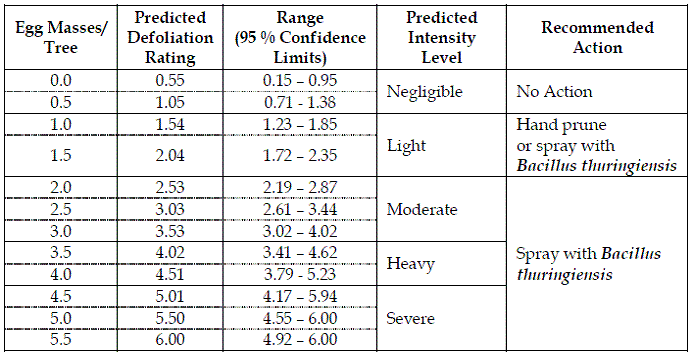
Table 8 – Predicted defoliation and recommended control actions for pine processionary caterpillar in young Pinus brutia plantations in the TCC based on the regression of instar II and III larvae over egg-masses (y = 0.08 + 0.83x) and the regression of defoliation rating over instar II and III larvae (y = 0.59 + 1.16 x) – 2002 – 2003
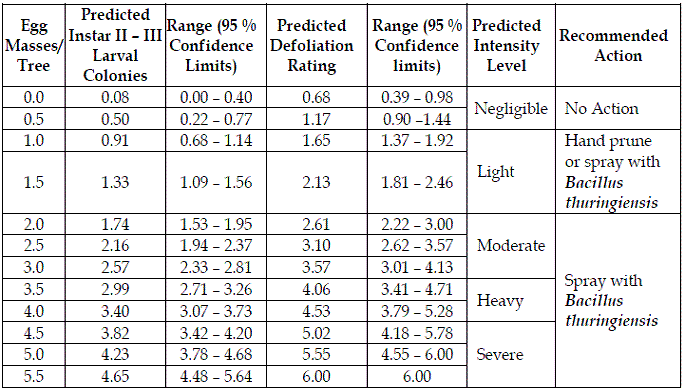
Discussion and conclusions
Counts of egg masses and/or early larval colonies of pine processionary caterpillar can be used to forecast intensity of defoliation and can serve as the decision criteria for management of pine processionary caterpillar in young pine plantations (trees up to 2.5 m in height) in northern Cyprus. This method has now been in use for several years.
The adaptation of the Hawksworth 6-class system for rating intensity of dwarf mistletoe infection in North America is an effective means of expressing intensity of defoliation by pine processionary caterpillar in young pine plantations in northern Cyprus. Moreover, the system is easy to use and foresters and forest technicians can apply this system with a minimum of training.
The authors recognize that it is desirable to have several years of data on the relationship between egg-masses and/or early larval densities and defoliation to ensure the reliability of this technique. Unfortunately, funding was only provided by the donor agencies for a single year of data collection.
Opportunities for additional refinements to this approach include:
1. Testing of the quadratic regression model y = a + bx + cx2 on the data to determine if this model has a better fit.
2. Relating catches of numbers of male adults using traps baited with a pheromone to defoliation (e.g. JACTEL et al., 2006). Use of pheromone trap catches, which provide earlier data on the potential for damage would allow more time for project planning and contracting for supplies and services for pest management activities.
References
BUXTON, R.D., 1983. Forest management and the pine processionary moth. Outlook on Agriculture 12(1): 34-39. [ Links ]
FREESE, F., 1967. Elementary statistical methods for foresters. USDA Forest Service, Agriculture Handbook 317: 87 pp. [ Links ]
HAWKSWORTH, F.G., 1977. The 6 class dwarf mistletoe rating system. USDA Forest Service, Rocky Mountain Forest and Range Experiment Station, Fort Collins, CO, General Technical Report RM-48, 7 pp. [ Links ]
JACTEL, H., MENASSIEU, P., VÉTILLARD, F., BARTHÉLÉMY, B., PIOU, D., FRÉROT, B., ROUSSELET, J., GOUSSARD, F., BRANCO, M., BATTISTI, A., 2006. Population monitoring of the pine processionary moth (Lepidoptera: Thaumetopoeidae) with pheromone-baited traps. Forest Ecology and Management 235(1-3): 96-106 [ Links ]
Acknowledgments
Funding for this work was made available by the United Nations Development Programme (UNDP) and the United States Agency for International Development (USAID) Bi-Communal Development Programme under a project entitled "Integrated Pest Management of Pine Processionary Caterpillar", executed by the United Nations Office of Project Services (UNOPS), Nicosia, Cyprus.













